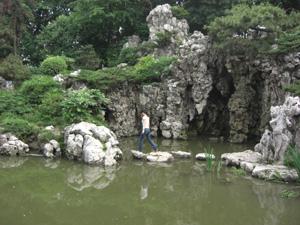Nanjing (Nanking) City Tour Package
Zhanyuan Garden
Among the five most famous gardens of Southern
China, Zhanyuan Garden is the only well preserved Ming Dynasty
(1368-1644) architectural complex in
Nanjing. It is the oldest (over 600 years) among all the gardens
in the city. Emperor Qianlong of the Qing Dynasty (1644-1911) once
came here and gave it the name of Zhanyuan. After the establishment
of the Kingdom of Heavenly Peace (Taiping Tianguo in Pinyin,
1851-1868), it became the residence of the Taiping Rebellion leaders
Yang Xiuqing, Xiao Youhe and Lai Hanying. With frequent wars, it lay
deserted for many years until its restoration by the government in
1960.
The garden is divided into two parts. The east part is
the museum where the cultural relics of Taiping Tianguo are
displayed. The Taiping Rebellion was a dynamic resistance against
the government led by farmers. The farmers finally overcame the
authorities and set up their own kingdom, namely the Kingdom of
Heavenly Peace. The museum has collected over 1,600 cultural relics,
including twenty cannons, the imperial seal and robe of the Heavenly
King, and the flag and sword of the army.
The west part is typical garden scenery consisting of
exquisite pavilions, clear water pools, winding pathways and a
variety of rockeries. Entering the garden, you will see a large
Taihu stone (a type of limestone found in the mountains around Taihu
lake) named Xianren Feng standing under crab-apple trees. This is
the most precious treasure of the garden. It is said to be the stone
relic of the Northern Song Dynasty (960-1127). The stone boasts five
special features of being tall and straight, bright and clear,
pretty and elegant, having natural stripes decorated and knotted
holes linked with each other.
Jingmiao Tang is the main structure of the garden.
Encircled by water and rockeries, the hall resembles a water
pavilion. To its east, there is another strange Taihu stone called 'Xuelang
Shi'. It is said that the three Chinese characters on the stone were
carved by Su Shi, a great poet of the Northern Song Dynasty. There
are countless hollows and wave-like stripes on the surface of the
stone. Under the different lights, every side of the stone takes on
a different appearance.
Standing on the south side of the hall, you can
appreciate the South Rockery covered by colorful flowers and green
trees. Although it is less than 33 feet high, the skillfully
designed crags, waterfalls, valleys and stone caves make it look
like a natural hill. The North Rockery is famous for its stone
caves, such as 'Twisted Dragon', 'Lying Tiger' and 'Three Apes'
which have been renowned since the Ming Dynasty. Additionally, the
two rocks projecting over the water are first class examples among
similar examples in any of Southern China gardens. The West Rockery,
like a dragon winding its way over the horizon, boasts the pavilion
'Suihan Ting'. Around the pavilion, bamboos, pines and plums are
scattered, making the pavilion both poetic and charming. These three
rockeries, together with the crystal clear pools linking them with
each other, form an amazing picture of this garden.
|

